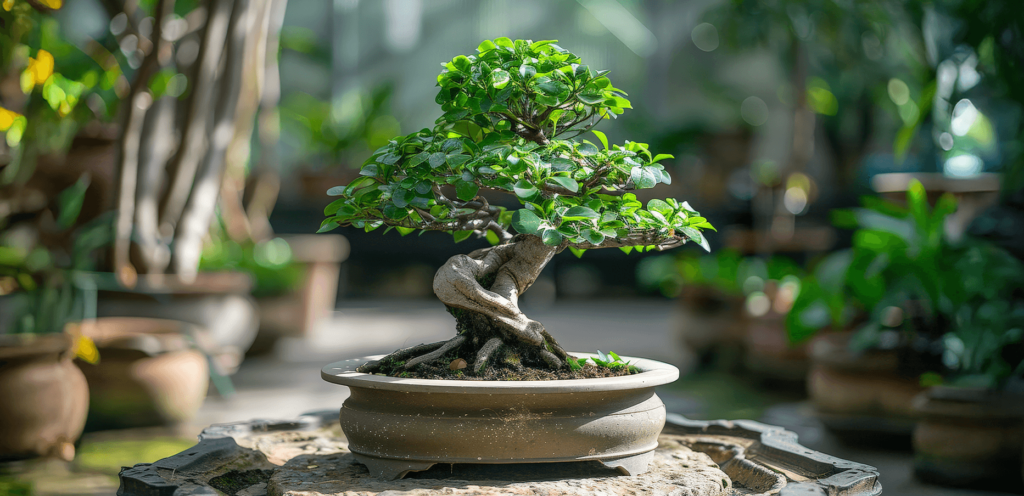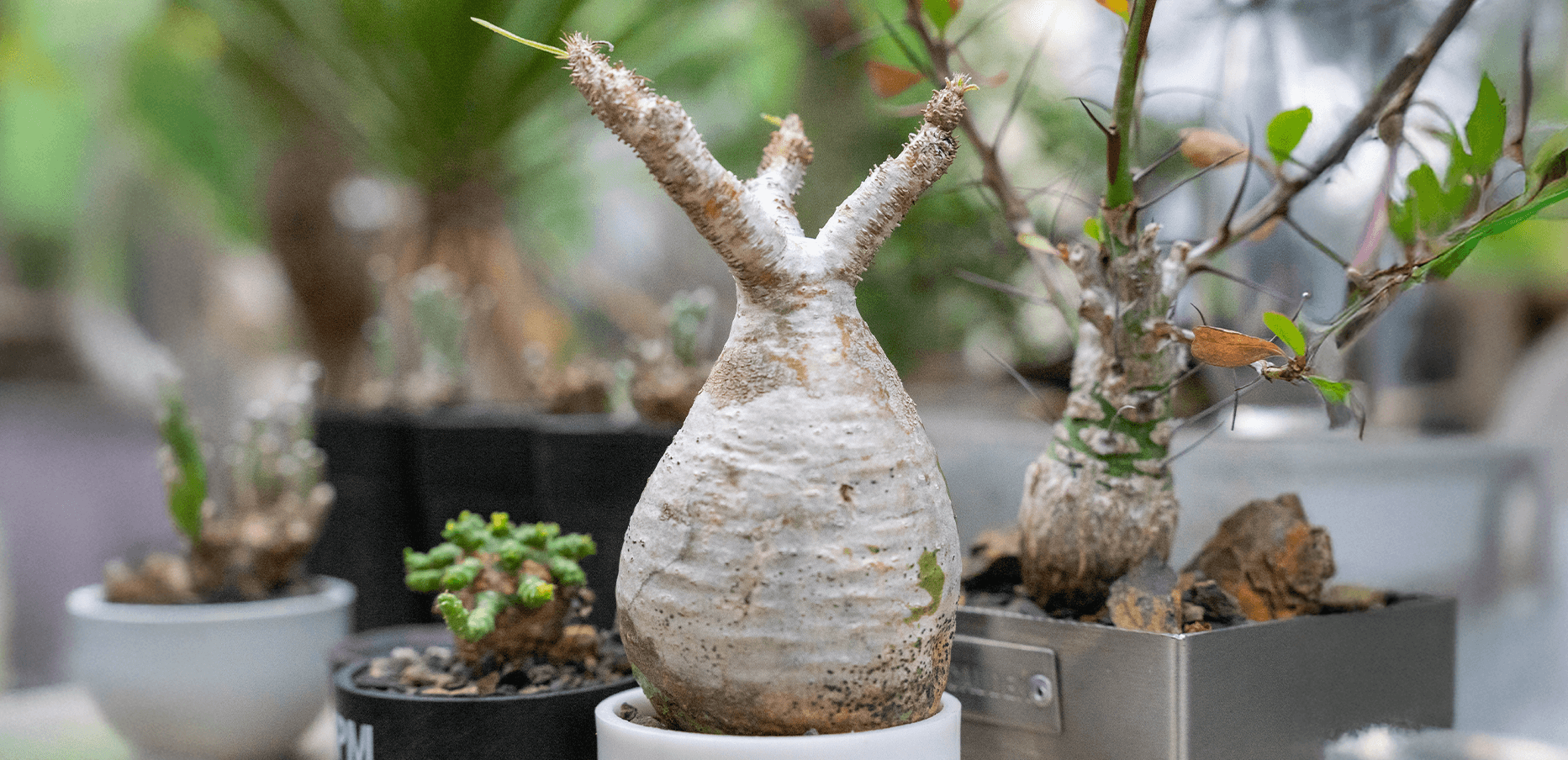- Momordica sessilifolia: This species develops a fascinating, swollen caudex that can reach a significant size. It has a vining growth habit with attractive foliage, making it visually interesting. While less common, it’s a fantastic option for those seeking a unique caudex plant. Seedings are readily available in gardens and domestic bushes. Only seedling produces caudex. So choose a healthy seedling to select for bonsai transformation.
- Banyan tree (Ficus benghalensis): While not typically considered a caudex plant, the Banyan tree can be styled to resemble a caudex through careful bonsai techniques. By heavily pruning the roots and carefully pruning and training the aerial roots, you can encourage the base of the tree to thicken and become more pronounced, mimicking the swollen appearance of a true caudex. However, this process requires significant time, patience, and expert guidance from experienced bonsai artists specializing in Ficus trees. Improper pruning or training can severely damage the tree.
- Bombax ceiba, commonly known as the Silk Cotton Tree or Kapok Tree, isn’t typically considered a caudex plant. However, it does possess some characteristics that might be of interest to caudex enthusiasts: Buttressed Base: Mature Bombax ceiba trees often develop a buttressed base, which is a thickening and widening of the trunk at the base. This provides stability to the tree and can create a visually interesting feature. Bonsai Potential: While not a true caudex, the buttressed base of the Silk Cotton Tree can be emphasized through bonsai techniques, creating a unique and visually appealing specimen. Key Points to Remember: Size: Bombax Ceiba is a massive, rapidly growing tree, making it unsuitable for most indoor or small outdoor spaces. Bonsai Challenge: Shaping a mature Silk Cotton Tree into a bonsai form demands substantial expertise and patience. In Conclusion: While Bombax ceiba doesn’t conform to the typical definition of a caudex plant, its buttressed base and potential for bonsai styling make it an intriguing subject for those interested in unique plant forms. However, it’s essential to consider the tree’s size and growth habits before attempting to cultivate or shape it.
- Although not a typical caudex plant, Butea monosperma can be styled to resemble a caudex through advanced bonsai techniques. Root Reduction and Training: By meticulously pruning the roots and carefully training the remaining root system, you can encourage the tree’s base to thicken and become more pronounced. This process can create a visually striking effect that mimics the appearance of a caudex. Careful pruning of branches and shaping of the foliage can further enhance the caudex-like appearance by minimizing the overall size of the tree and emphasizing the thickened base. This process is extremely challenging and time-consuming. Butea monosperma is a relatively large tree and shaping it into a caudex-like bonsai requires years of dedicated effort and expert bonsai skills. Risk of Damage: Improper pruning or training can severely damage the tree. It’s crucial to seek guidance from experienced bonsai artists specializing in advanced techniques. In conclusion, while Butea monosperma isn’t a natural caudex plant, it can be meticulously shaped using advanced bonsai techniques to resemble a caudex. This showcases the remarkable versatility of bonsai and its potential to transform even non-traditional caudex species into visually captivating forms.
- While Jatropha curcas is not typically known for a prominent caudex like some other Jatropha species, it can still develop a thickened base over time, especially under specific growing conditions. Caudex: The caudex of Jatropha curcas is often less pronounced compared to species like Jatropha podagrica. However, with age and proper care, it can develop a thickened base that adds to the plant’s visual appeal. Factors Influencing Caudex: Several factors can influence the development of a caudex in Jatropha curcas. Older plants are more likely to have a more developed caudex. Creating stressful conditions like drought or limited water availability can encourage caudex development as the plant stores water in its base. Regular pruning can help shape the plant and encourage a more prominent caudex. It’s important to exercise caution when handling Jatropha curcas as it contains toxic substances. Always wear gloves and wash your hands thoroughly after handling the plant. By understanding these factors and providing the right care, you can encourage the development of a more pronounced caudex in your Jatropha curcas, adding to its unique beauty and visual interest.

Though below mentioned plants below are not true Indian subcontinent origin, they are easily available and excellent caudex plants.
Jatropha podagrica is commonly known as the Buddha Belly plant or Gout Plant. Native to the neotropics of Central America and southern Mexico, this succulent shrub thrives in seasonally dry tropical environments. Its distinctive swollen base, resembling a Buddha’s belly, makes it a popular choice for caudex enthusiasts due to its unique shape and relatively easy care.
Moving on, we have Beaucarnea recurvata, also known as the Ponytail Palm. This plant boasts a thick, bulbous base that stores water, making it a slow-growing plant that can live for many years. It’s a patient choice for those who appreciate the rewards of nurturing a living work of art.
Euphorbia stellata: This succulent, with its star-shaped caudex, is a favorite among bonsai enthusiasts. It’s a slow-growing plant that needs careful watering to avoid root rot.
Ficus petiolaris, also known as the Rock Fig, has a gnarled, twisted trunk and large, leathery leaves. It’s a slow-growing plant that can live for many years, making it a valuable addition to any collection.
Lastly, we have Pachypodium lamerei, native to Madagascar, and known as the Madagascar Palm features a spiny trunk and can grow quite tall, adding a dramatic touch to any collection. Although it’s not a native plant in the Indian subcontinent, it has become increasingly common in Indian gardens. The species has naturalized in Indian habitats, transforming the landscape.
These are just a few examples of the many common Indian plants that can be transformed into caudex. With a bit of patience and care, you can create a beautiful and unique collection of these captivating plants.
